فهم الوحدات النمطية في مقال واحد: حلول قابلة للتوصيل لاختناقات أداء blockchain
كتبه: @twilight_momo
مُرشِد: @CryptoScott_ETH
ملخص طويل
-
Monolithic blockchains are known for their comprehensiveness, independently taking on all aspects of the network, from data storage to transaction verification, etc. Modular blockchains, by separating different functions of blockchains into independent modules, can provide performance support and smooth user experience for specific functions, solving the impossible triangle problem to a certain extent.
-
As the first blockchain platform to support smart contracts, ايثريوم provides fertile soil for modular design. With the development of blockchain technology, the Bitcoin ecosystem has also begun to explore the possibility of modularization by adding new modules to achieve more advanced functions, such as improved privacy protection, more efficient transaction processing, or enhanced smart contract functions.
-
Modular technology represents a more soul-based pluggable product idea . In the future, more flexible and customizable blockchain solutions will emerge, and various services and functions can be easily plugged in and out like Lego blocks. This flexibility enables developers to quickly build and deploy blockchain solutions based on the needs of specific application scenarios.
1. What is a modular blockchain?
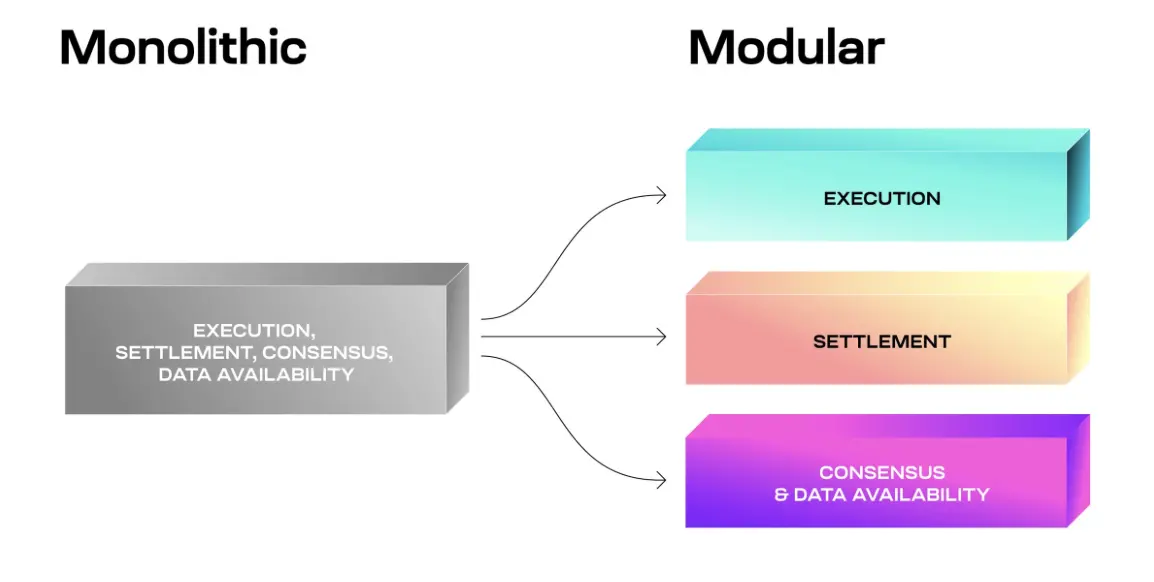
Source: Celestia.org
When we discuss modular blockchain, we must first understand the concept of Monolithic Blockchain . Monolithic chains, such as Bitcoin and Ethereum, are known for their comprehensiveness and independently undertake all aspects of the network, from data storage to transaction verification to smart contract execution. In this process, the monolithic chain plays the role of a generalist and is involved in all aspects.
Taking Ethereum as an example, a mature single blockchain can generally be divided into four architectures:
-
Execution Layer
-
طبقة الترسيب
-
طبقة توفر البيانات
-
Consensus Layer
The following figure explains the role of each layer of the architecture in detail by comparing the bookkeeping on the blockchain to a ball game:

Through this analogy, we can more clearly understand how the various architectures of blockchain work together. Monolithic blockchain is to concentrate all functions on the same chain for execution, while modular blockchain is a new type of blockchain architecture that decomposes the blockchain system into multiple specialized components or layers, each of which is responsible for handling specific tasks such as consensus, data availability, execution and settlement. Modular blockchain is like a group of specialists who focus on deep mining and technological innovation in their respective fields. This focus enables modular blockchains to provide excellent performance and user experience in specific functions. For example, they can provide faster transaction processing speeds at a lower cost.
من ناحية node architecture , monolithic chains rely on full nodes, which must download and process a copy of the entire blockchains data. This not only places high demands on storage and computing resources, but also limits the speed at which the network can expand. In contrast, modular blockchains use a light node design that only processes block header information, significantly improving transaction speed and network efficiency.
A significant advantage of modular blockchains is their flexibility and collaboration. They are able to outsource non-core functions to other experts, forming a synergy and achieving a significant improvement in overall performance. This design philosophy is similar to Lego blocks, allowing developers to freely combine different modules according to project requirements to create diverse solutions. Although monolithic chains have advantages in global control, security, and stability, they also face challenges in scalability, difficulty in upgrading, and adapting to new needs. Modular blockchains stand out for their high flexibility and customizability, simplifying the creation and optimization process of new blockchains.
However, modular blockchain also faces its own unique challenges. Its complex architecture increases the workload of developers in design, development and maintenance. As an emerging technology, modular blockchain has not yet undergone comprehensive security testing and the test of market fluctuations, and its long-term stability and security still need further verification.
2. Why do we need modular blockchain?
Why has modular blockchain technology received so much attention and been predicted to be a future trend? This is closely related to the famous impossible triangle theory in the blockchain field.
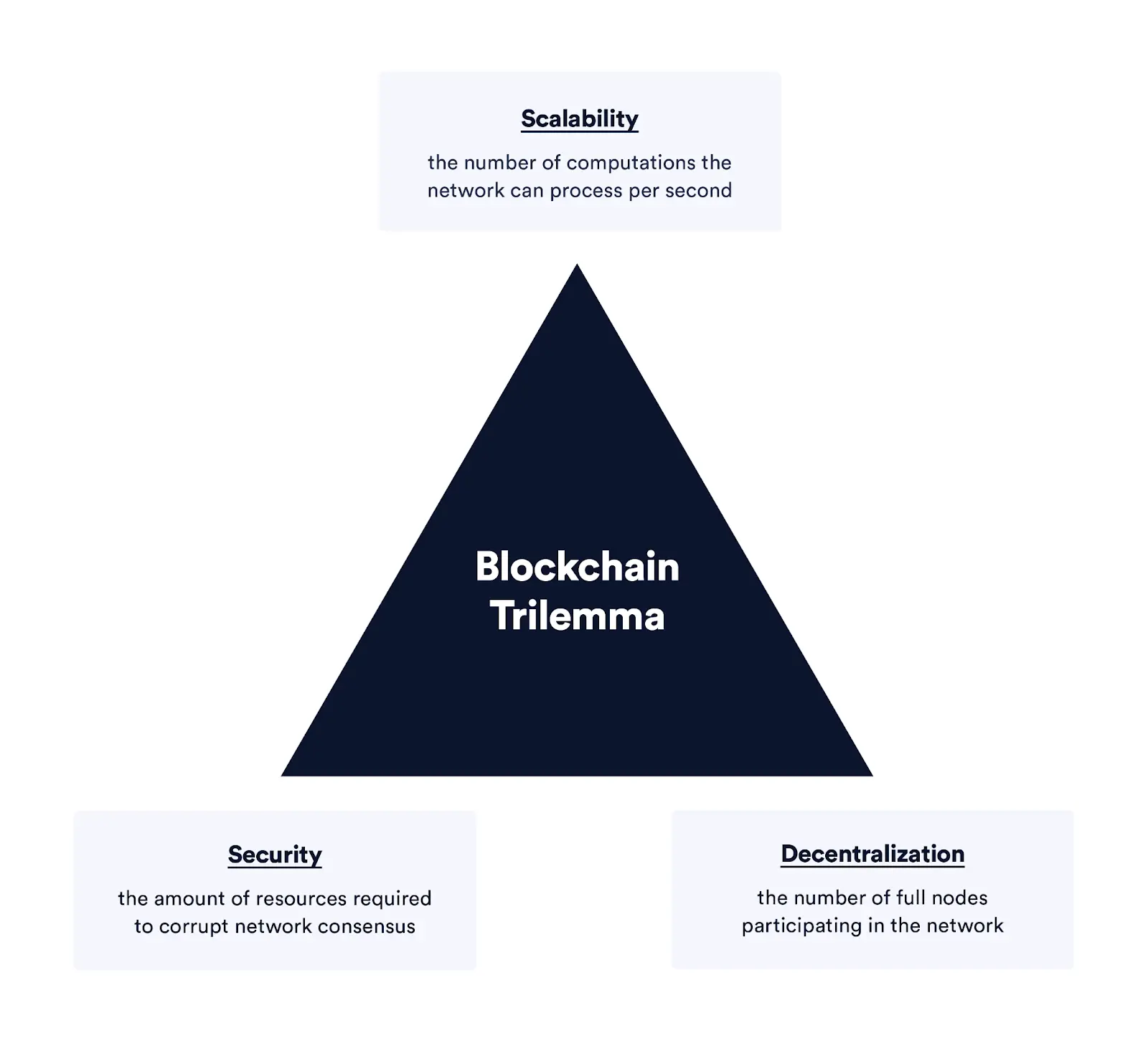
Source:chainlink
The impossible triangle of blockchain refers to the difficulty for a blockchain network to achieve optimal conditions in the three core attributes of security, decentralization and scalability at the same time.
-
Scalability focuses on the networks ability to handle a large number of transactions and its ability to maintain efficient and low-cost operation as the number of users and transactions grows. It is usually measured by TPS (transactions per second) and latency (the time it takes for a transaction to be confirmed).
-
حماية refers to the cost and difficulty of protecting the blockchain network from attacks. For example, Bitcoin’s POW mechanism requires attackers to have more than 51% of the computing power of the entire network, while Ethereum’s POS mechanism requires more than ⅓ of the nodes to collude.
-
اللامركزية describes that the operation of the network does not rely on a single central node, but is distributed across many nodes. The more nodes and the wider the geographical distribution, the higher the degree of decentralization of the network.
The core idea of the impossible triangle is that it is difficult for a blockchain system to achieve the best of all three characteristics. For example, among many public chains, Bitcoin and Ethereum have outstanding performance in decentralization and security due to their wide node distribution and sufficient number of nodes. However, they sacrifice a certain degree of scalability, resulting in slower transaction speeds and higher transaction fees: Bitcoins block time is about 10 minutes, Ethereums TPS is about 13, and when the transaction volume surges, Ethereums transaction fees may be as high as hundreds of dollars.
It is in this context that modular blockchain technology came into being. It solves the challenges of scalability and transaction costs of traditional public chains by assigning different functions to specialized modules. For example, Bitcoins Lightning Network and Ethereums Rollup technology are both manifestations of modular thinking.
The advantage of modular blockchain lies in its layered architecture, which allows each layer to be optimized for specific needs. The data layer can focus on data storage and verification, while the execution layer can handle smart contract logic. This separation not only improves performance and efficiency, but also promotes interoperability between different blockchains, providing a foundation for building an open and interconnected ecosystem.
In summary, modular blockchain technology provides a new way to solve the limitations of traditional public chains. It achieves higher scalability and lower transaction costs while maintaining decentralization and security, which has far-reaching significance for the widespread application and long-term development of blockchain technology.
3. Modular blockchain track-project analysis
Modular blockchains can be divided into different types according to their architectural characteristics. Among these types, the data availability layer and the consensus layer are often designed as a unified whole due to their close interdependence. This is because when a node receives transaction data, it usually also determines the order of transactions, which is the core of blockchain security and immutability.
Based on this design principle, we can understand different projects of modular blockchain from three aspects: execution layer, data availability layer, consensus layer, and settlement layer.
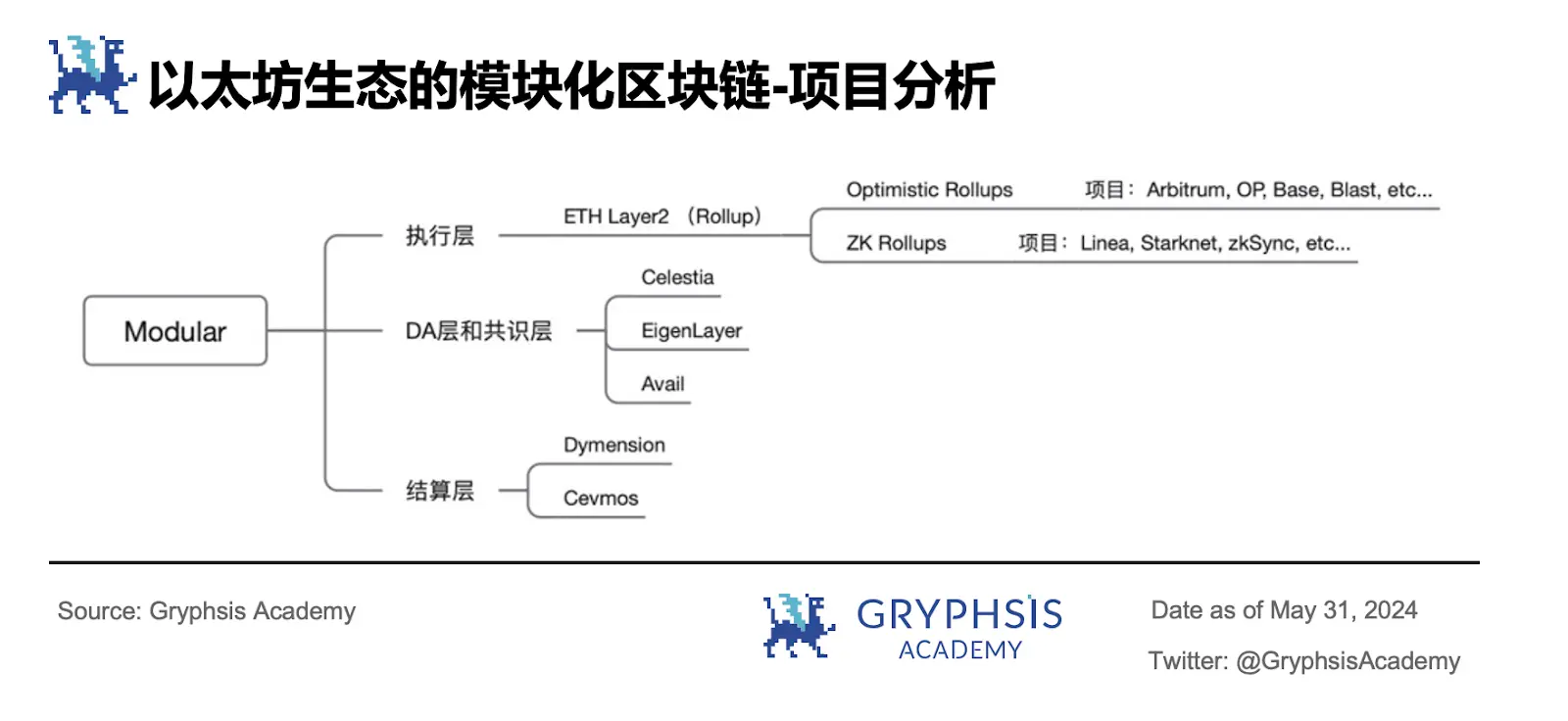
3.1 Execution Layer
Layer 2 technology, as an extension of the execution layer in the blockchain architecture, is a manifestation of the concept of modular blockchain. It is committed to improving the scalability of the main chain by building off-chain networks, systems or technologies on top of the underlying blockchain.
Layer 2 solutions allow for faster and more cost-effective transaction processing while maintaining the security and decentralization of the underlying blockchain. According to the dune dashboard created by @0x ning, it can be seen that the average gas consumed by Layer 2 verification and liquidation in the Ethereum ecosystem is less than 10%, which greatly saves users transaction costs.
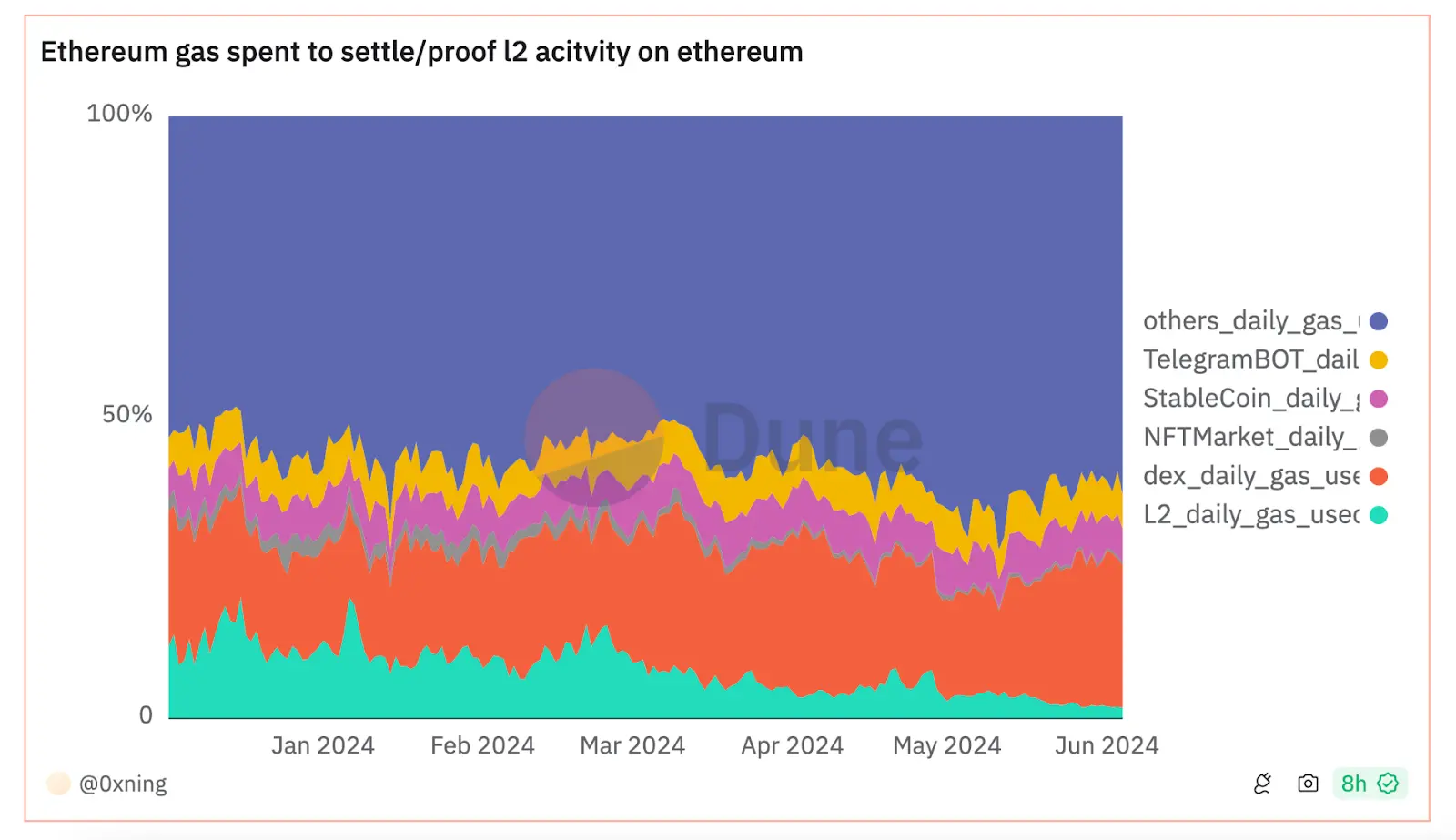
مصدر: https://dune.com/0xning/ethereum-gas-war
Rollup technology is currently the most mainstream solution for Layer 2. Its core concept is off-chain execution, on-chain verification. It performs calculations and other tasks off-chain, and then uploads calldata back to the main network.
Off-chain execution
In the Rollup model, transactions are executed off-chain, and the underlying blockchain is only responsible for verifying transaction proofs in smart contracts and storing raw transaction data. This design significantly reduces the computational burden of the main chain and reduces storage requirements, allowing more efficient transaction processing.
To further reduce costs, Rollup uses transaction packaging technology. It can be likened to the containerization of goods in logistics. Sending each item separately will incur high shipping costs. Rollup technology significantly reduces the cost of each transaction by packaging multiple transactions together and only requiring one transportation.
On-chain verification
On-chain verification is key to the security of Layer 2 networks. Layer 2 networks must provide cryptographic proofs to resolve potential disagreements on the underlying blockchain. Currently, the two mainstream proof mechanisms are proof of fraud and proof of validity, which support Optimistic Rollups and ZK Rollups respectively.
Fraud Proofs for Optimistic Rollups
Optimistic Rollups adopts an optimistic assumption that all transactions are valid by default unless there is clear evidence of an error. This model relies on proofs of error (fraud proofs) during the challenge period, and any network participant can submit proofs to challenge the state of the smart contract, ensuring the fairness and transparency of the network.
According to L2 BEAT data, there are currently 16 Layer 2s that use the Optimistic Rollups mechanism, such as: Arbitrum, OP, Base, Blast, etc.
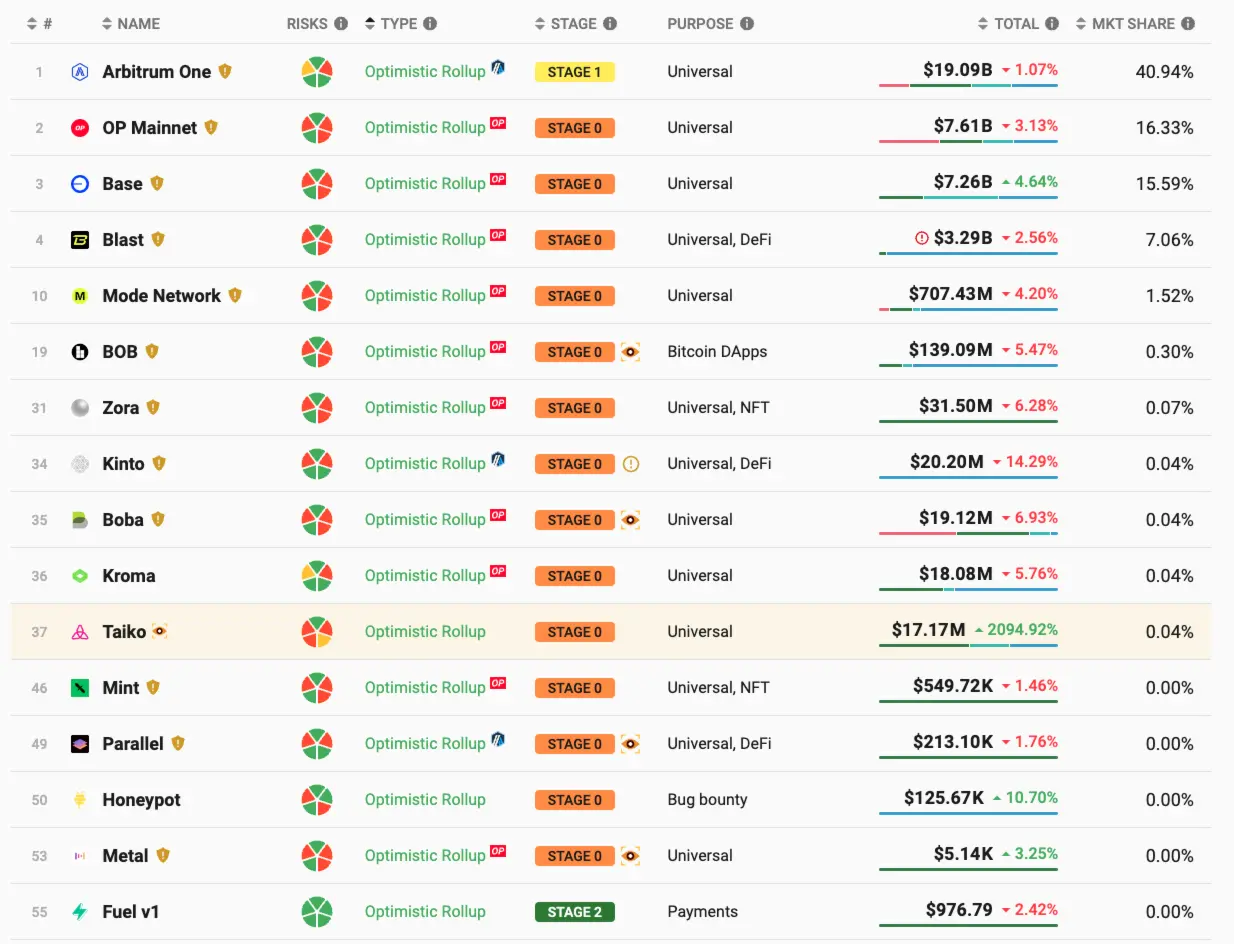
Source: l2 beat.com
Proof of Validity for ZK Rollups
Unlike Optimistic Rollups, ZK Rollups takes a more cautious approach, requiring all transactions to be proven valid before being accepted. This proof mechanism is similar to a verification process, ensuring that every transaction and calculation in the Layer 2 network is accurate. In short, validity proof is the cornerstone of ZK-Rollups, which requires that each batch of transactions is accompanied by corresponding proofs, thereby ensuring that the smart contracts on the underlying blockchain can verify and approve state changes. For verification nodes, ZK Rollups provides a zero-error settlement mechanism because each transaction must pass strict validity verification.
According to L2 BEAT data, there are currently 11 Layer 2s that use the ZK Rollups mechanism, such as Linea, Starknet, zkSync, etc.

Source: l2 beat.com
3.2 Data Availability Layer and Consensus Layer
3.2.1 Celestia

As a pioneer in the field of modular blockchain, Celestia is essentially a data availability layer that provides a solid foundation for the development of dApps and Rollups. By deploying on Celestias data availability layer and consensus layer, application developers can focus on optimizing execution logic and leave the complexity of data availability and consensus mechanisms to Celestia.
Celestias architectural design provides a variety of solutions for modular expansion. Its architecture mainly includes the following three types:
-
Sovereign Rollup : Celestia provides the data availability layer and consensus layer, while the settlement layer and execution layer are independently implemented by their respective sovereign chains.
-
Settlement Rollup ( such as the Cevmos project): Based on the DA and consensus layer provided by Celestia, Cevmos provides settlement layer services, while the application chain assumes the role of the execution layer.
-
Celestium : The data availability layer is managed by Celestia, the consensus layer and settlement layer rely on the powerful network of Ethereum, and the application chain continues to focus on the execution layer.

Celestia uses a number of innovative technologies to significantly reduce data storage costs and optimize storage efficiency.
Erasure Coding Technology
One of Celestias innovations is the application of erasure codes. In the paper Data Availability Sampling and Fraud Proofs co-authored by Mustafa Albasan (one of the founders of Celestia) and Vitalik Buterin, a new architectural idea is proposed, that is, full nodes are responsible for block production, while light nodes are responsible for block verification. Erasure code technology introduces redundancy during data transmission to ensure that the original data block can be fully restored even in the case of up to 50% data loss.
This mechanism means that in order to ensure 100% availability of block data, block producers only need to publish 50% of the block data to the network. If a malicious producer attempts to tamper with 1% of the block data, they actually need to tamper with the entire 50% of the data, which greatly increases the cost of the malicious actor.
Data availability sampling
Celestia solves the scalability problem of blockchain by introducing Data Availability Sampling (DAS) technology. The DAS workflow includes the following key steps:
-
Random sampling : Light nodes perform multiple rounds of random sampling on block data, requesting only a small portion of the block data each time.
-
Gradually increase confidence : As a light node completes more rounds of sampling, its confidence in the availability of data gradually increases.
-
Reaching the confidence threshold : Once a light node reaches a preset confidence level (such as 99%) through sampling, it considers the data of the block to be available.
This mechanism enables light nodes to verify the availability of block data without downloading the entire block data, ensuring the integrity and availability of blockchain data. Celestia focuses on providing data availability rather than execution status, which improves block productivity. Each block has more space and can accommodate more sampled data, thereby significantly improving TPS (transactions per second).
3.2.2 EigenLayer

EigenDA is a secure, high-throughput and decentralized data availability service, and is the first active verification service (AVS) launched on EigenLayer. AVS can be understood as a node operator, which is a part of the thousands of node operators on Ethereum. On the basis of their main job (responsible for Ethereum consensus verification), they take on some additional private work (serving rollup and other networks with consensus verification requirements) to obtain additional income. With the increase in the number of re-staking Ethereum and more AVS joining the EigenLayer ecosystem in the future, Rollups can obtain lower transaction costs and higher security composability in the EigenLayer ecosystem.
EigenLayer is a re-staking protocol based on Ethereum. It uses the stakers of the Ethereum consensus layer as validators, which uses part of the security of Ethereum to avoid the trust risk of centralized service providers or their own tokens, thus lowering the development threshold for other projects. At the same time, it also enhances Ethereums trust network and increases Ethereums value and influence.
In terms of architecture, EigenDA uses ZK technology to verify the state data submitted by Layer 2, and the EigenDA network, whose consensus security is guaranteed by Restaking ETH, is responsible for finality. Finally, the state data of Layer 2 is submitted and saved to the Ethereum mainnet. Therefore, EigenDA is equivalent to a subcontractor for the verification and finality of the DA service of the Ethereum mainnet, rather than a competitor like Celestia.
3.2.3 Avail

Avail is a modular blockchain project announced by the Polygon team in June 2023. It was spun off from Polygon in March this year and operated as an independent entity. Avail is currently running on the testnet and has just completed a $43 million Series A financing round led by Dragonfly and Cyber Fund.
The core architecture of Avail is mainly composed of three parts: Avail DA, Avail Nexus, and Avail Fusion. Avail DA is a modular data availability layer that provides DA services for various blockchains, just like Celestia. Avail Nexus is a standardized cross-chain messaging protocol, similar to Cosmos IBC protocol, which provides equal interoperability between various cross-chains. Avail Fusion introduces a multi-asset pledge POS consensus, with the goal of providing secure consensus guarantees for the entire Avail network.
In terms of technology, Avail DA uses Kate polynomial commitments to avoid fraud proofs, does not need to assume that most nodes are honest, and does not rely on full nodes to make data available. This is different from Celestias architecture, which is based on fraud proofs, so there is an essential difference between the two at the technical level.
With the emergence of modular data availability blockchain projects such as Celestia and Avail, the modular DA War will become more and more intense, and the functionality of Ethereum as a DA layer will also be diverted. In the future, it is very likely that there will be a one super and many strong competition landscape.
3.3 Settlement Layer
3.3.1 Dynamic

Dymension is a modular blockchain platform based on Cosmos that provides a concise framework for RollApp development through built-in scalability rollup technology. In the Dymension architecture, developers can focus on the implementation of business logic and use the Rollup Development Kit (RDK) and a dedicated settlement layer to quickly deploy Rollups for specific applications.
The architecture of Dymension consists of two core components: RollApp and Dymension Hub.
RollApp is a fusion of Rollup and App. It is a high-performance modular blockchain dedicated to specific applications on Dymension. RollApp can be presented in many forms, including but not limited to dedicated Layer 2 solutions for decentralized applications such as DeFi platforms, Web3 games, NFT trading markets, etc.
In RollApp, the Sequencer plays a key role in verifying, sorting, and processing local transactions. After the block is packaged, the data will be passed to the peer full node and published on the chain to the data availability network selected by RollApp, such as Celestia. After receiving a response from Celestia, the Sequencer sends its state root to the Dymension Hub for consensus formation and settlement.
As the center of the entire ecosystem, Dymension Hub assumes the functions of consensus layer and settlement layer. It receives the state root from RollApp and provides final transaction confirmation and settlement services for RollApps.
Through this design, Rollup can delegate the tasks of consensus and settlement to Dymension Hub, and delegate the tasks of data storage and verification to DA networks such as Celestia. In this way, Rollup can share the economic security of these two networks while focusing on improving the execution efficiency and user experience of the application itself.
3.3.2 Cevmos
 Cevmos, whose name combines Celestia, EVMos, and CosmOS, aims to provide a settlement layer for EVM-compatible rollups.
Cevmos, whose name combines Celestia, EVMos, and CosmOS, aims to provide a settlement layer for EVM-compatible rollups.
Since Cevmos itself is a rollup, all rollups built on it are collectively referred to as settlement rollups. Each rollup redeploys existing rollup contracts and applications on Ethereum through a minimized two-way trust bridge with the Cevmos rollup, reducing the workload of migration. Rollups on Cevmos will publish data to Cevmos, which then batches the data and publishes it to Celestia. Just like Ethereum, Cevmos will perform rollup proofs as a settlement layer.
4. Modular blockchain in the Bitcoin ecosystem
With the inscription wealth creation effect brought by the Ordinals protocol and the approval of the Bitcoin ETF, multiple favorable factors have converged to inject new vitality into the Bitcoin ecosystem. The markets attention has been quickly attracted to the Bitcoin ecosystem, and institutional investors funds have also poured into this field, showing their confidence and expectations for the future development of the Bitcoin ecosystem.
In this context, Bitcoin Layer 2 technology is booming, with numerous technical solutions emerging, forming a diversified and vibrant technology ecosystem. Various innovative solutions have emerged, jointly promoting the expansion and optimization of the Bitcoin network.
Although the industry has not yet reached a unified consensus on the precise definition of Bitcoin Layer 2, this article will draw on the concept of Ethereums modular blockchain and explore the possibility and methods of building Bitcoin Layer 2 from a modular perspective.
4.1 Why does Bitcoin need modularity?
The Ethereum network is known for its Turing-complete smart contract functionality, which can store and verify historical states, thereby supporting complex decentralized applications (DApps). In contrast, the Bitcoin network is a stateless, non-smart contract network, and its imperfections in system design are mainly due to two aspects:
1. Limitations of the UTXO Account System
In the blockchain world, there are two main ways of keeping records: the account/balance model and the UTXO model. The UTXO model used by Bitcoin is in stark contrast to the account/balance model used by Ethereum.
In the Bitcoin system, although users see account balances in their wallets, in fact, the Bitcoin system designed by Satoshi Nakamoto does not include the concept of balance. The so-called Bitcoin balance is actually a concept derived from the wallet application based on UTXO. UTXO stands for unspent transaction output, which is the core of Bitcoin transaction generation and verification. Each Bitcoin transaction consists of inputs and outputs. Each transaction consumes (spends) one or more inputs and generates new outputs. These newly generated outputs then become new UTXOs, waiting to be consumed by future transactions.
As a minimalist technical architecture for asset transfer and settlement, the UTXO model is difficult to expand to support complex functions such as smart contracts.
2. Non-Turing-complete scripting languages
Bitcoins scripting language does not support all types of calculations, and it is not Turing complete due to the lack of loops and conditional control statements. Although this feature helps reduce hacker attacks and improve network security, it also limits Bitcoins ability to execute complex smart contracts.
Because of the imperfect design of the Bitcoin system, it needs to rely on external modular expansion for more complex functions. In this regard, Bitcoins demand for modularization is undoubtedly more urgent than Ethereum. The execution layer, data availability layer, consensus layer, and cross-chain interoperability layer in its ecosystem all need to be encapsulated and expanded in a modular way.
4.2 Analysis of modular projects in Bitcoin ecosystem
4.2.1 Execution Layer – Bitcoin Layer 2
Merlin
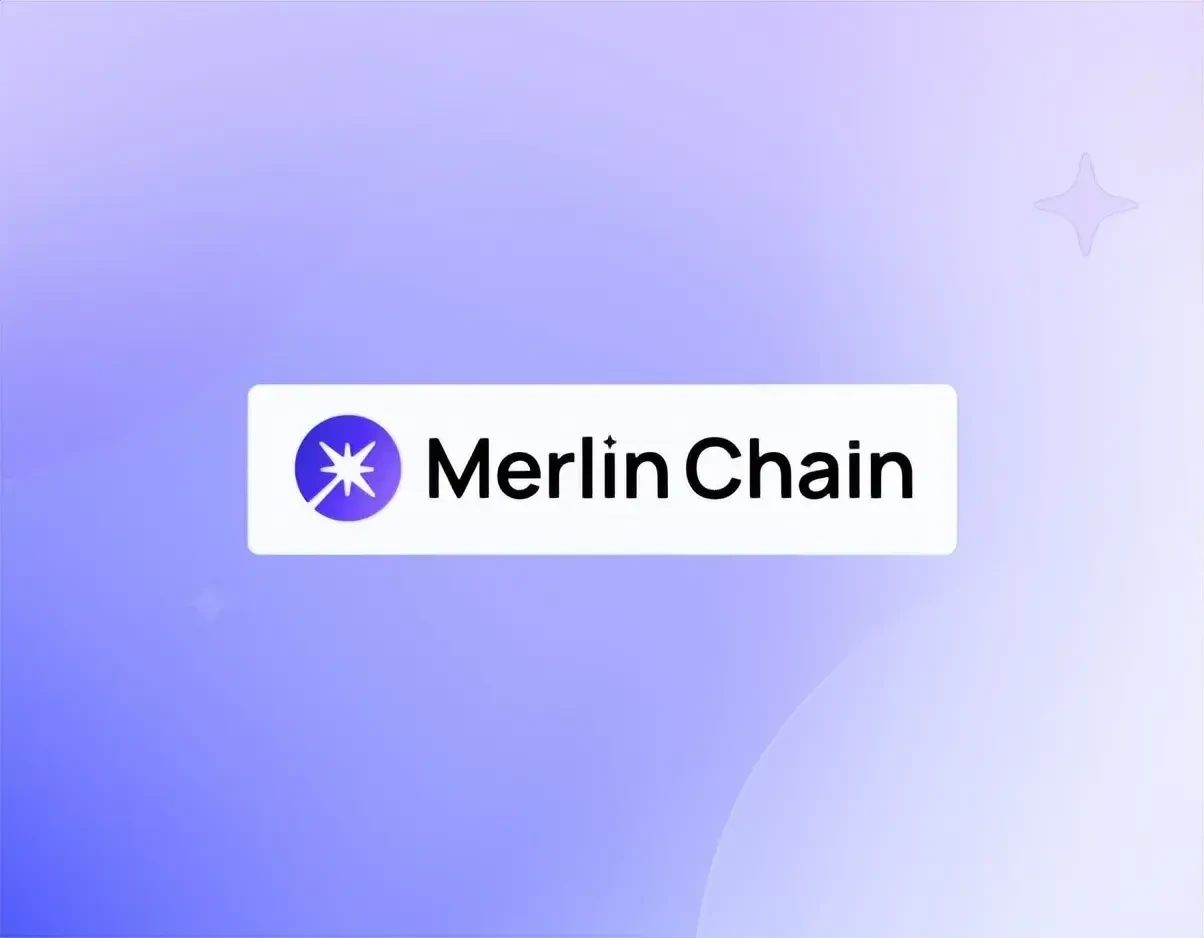
Merlin Chain currently has the highest TVL in the Bitcoin Layer 2 track, reaching billions of dollars, and can be said to be the most attractive project in the Bitcoin ecosystem. As a Bitcoin Layer 2 network, Merlin Chain supports a variety of native Bitcoin assets while also being compatible with EVM, demonstrating its dual consideration of the Bitcoin ecosystem and the Ethereum ecosystem.
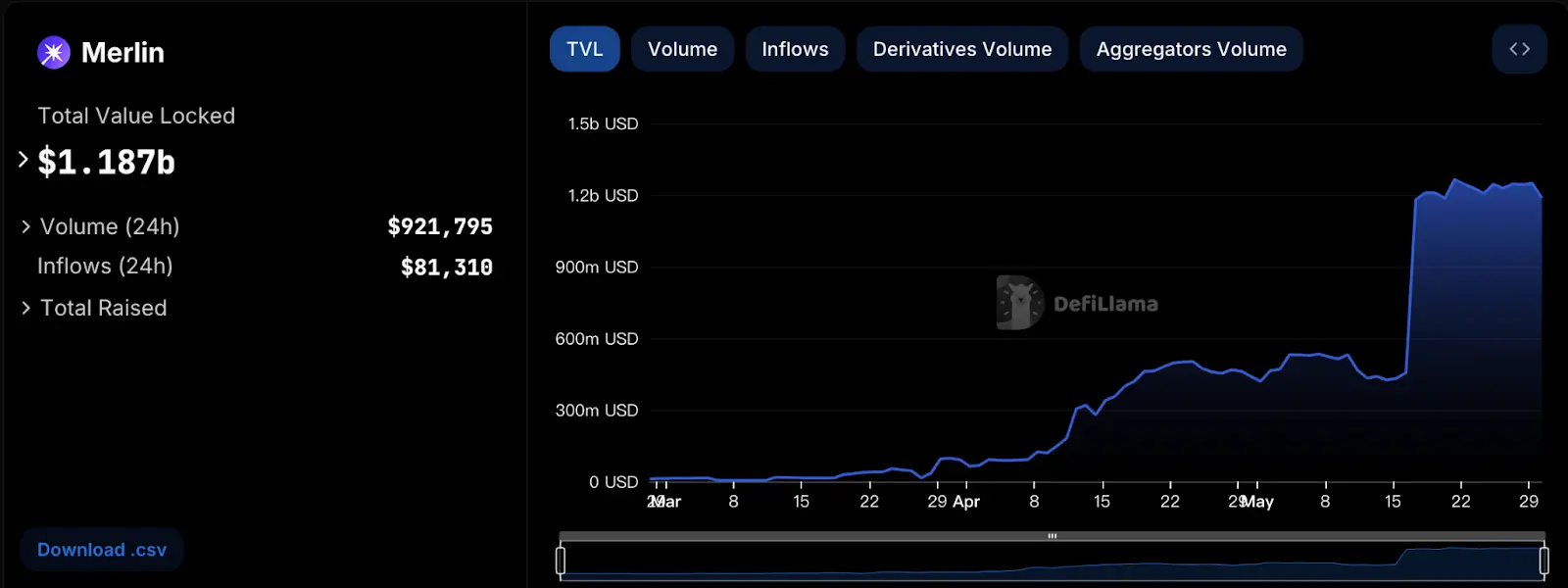
Source: https://defillama.com/chain/Merlin
Merlin’s functionality revolves around ZK-Rollup networks, decentralized oracle networks, and on-chain fraud prevention.
ZK-Rollup Network
At the heart of ZK-Rollups is the use of zero-knowledge proofs, a cryptographic method that allows one party (the prover) to prove to another party (the verifier) that a statement is correct without revealing any information other than proving that the statement is correct.
Merlin Chain processes and calculates transactions off-chain to avoid high transaction fees and network congestion on the Bitcoin network. At the same time, ZK-rollup can compress multiple transaction proofs into batches, and the Bitcoin main chain only needs to verify a single proof that packages multiple transactions, which greatly reduces the workload of the main chain and improves transaction efficiency.
Decentralized Oracle Network
Merlins decentralized oracle network is equivalent to the role of DAC (Data Availability Committee) to check and ensure that the sorter has truthfully published the complete DA data off-chain. The decentralization of the oracle network lies in the fact that it adopts the form of POS. Anyone who pledges enough assets can run an oracle node. This pledge mechanism is very flexible and supports assets such as BTC and MERL, as well as proxy pledges similar to Lido.
On-chain fraud prevention
Merlin introduced the idea of BitVM and also adopted the optimistic ZK-Rollup mechanism. It can be simply understood as assuming that all ZK Proofs are trustworthy, and only punishing the operator when an error occurs. Because the verification is carried out on the Bitcoin mainnet, on the Bitcoin chain, due to technical limitations, it is impossible to fully verify ZK Proof, and only a certain step of the ZK Proof calculation process can be verified under special circumstances. Therefore, people can only choose to point out that there is an error in a certain calculation step of ZKP during the off-chain verification process, and challenge it through fraud proof.
4.2.2 Data Availability Layer Consensus Layer
شبكة بي²

B² Network adopts a modular design, with the Rollup layer (ZK-Rollup) responsible for execution, the data availability layer (B² Hub) responsible for data storage, and B² Nodes performing off-chain verification. The final settlement layer is the Bitcoin mainnet.
B² Networks ZK-Rollup layer uses the zkEVM solution, which is responsible for executing user transactions within the second-layer network and outputting related proofs. The Rollup layer is responsible for submitting and processing user transactions, while the DA layer is responsible for storing copies of the aggregated data and verifying related zero-knowledge proofs.

مصدر: https://docs.bsquared.network
B² Hub is a DA network built off-chain that supports data sampling and is considered a pioneer in modular Bitcoin expansion solutions. B² Hub draws on the design ideas of Celestia and introduces data sampling and erasure coding technology to ensure that new data can be quickly distributed to many external nodes and minimize the risk of data withholding. In addition, the Committer in B² Hub uploads the storage index and data hash of DA data to the Bitcoin chain for public access.
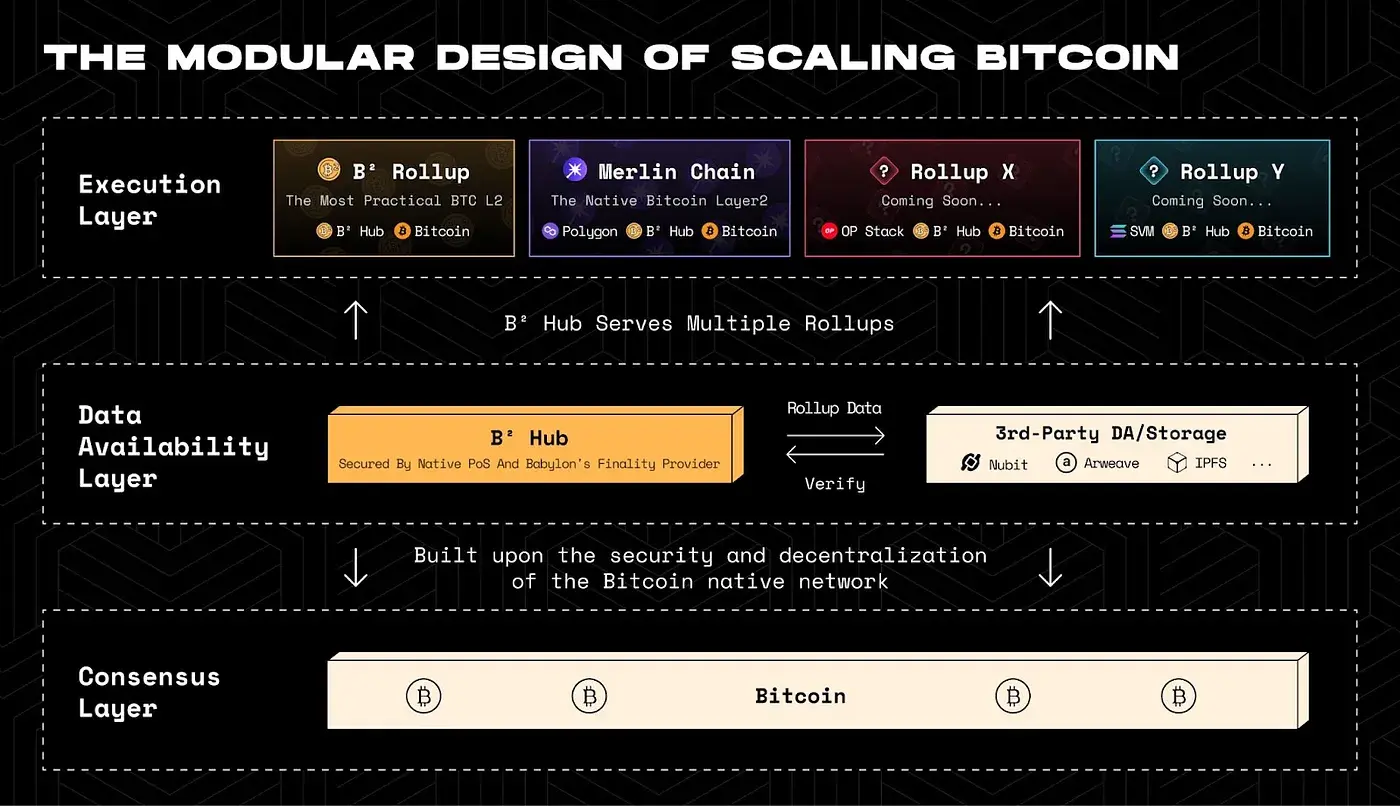
مصدر: https://blog.bsquared.network
According to the future plan of B² Network, the EVM-compatible B² Hub is expected to become the off-chain verification layer and DA layer of multiple Bitcoin Layer 2s, forming a functional extension layer off the Bitcoin chain. Given that Bitcoin itself cannot support many application scenarios, the method of building a functional extension layer off the chain will become an increasingly common phenomenon in the Layer 2 ecosystem.
As the first modular third-party DA layer of Bitcoin, B² Hub can help other Bitcoin Layer 2 use the Bitcoin main chain as the final settlement layer and inherit the security of Bitcoin, which is conducive to promoting the expansion of the Bitcoin network and enhancing the diversity of its applications.
5. الخاتمة
The slogan Modular is the future is gradually turning from an idea into reality. Modular blockchain technology, with its flexibility and scalability, provides a solid foundation for building the next generation of decentralized applications. This technology allows developers to select and combine different modules according to specific needs, thereby creating more efficient, secure and easy-to-maintain blockchain solutions.
The rise of modular blockchains represents a more soul-based pluggable product approach. In this approach, blockchain is no longer seen as a closed system, but an open, scalable platform where various services and functions can be easily plugged in and out like Lego blocks. This flexibility enables developers to quickly build and deploy blockchain solutions based on the needs of specific application scenarios.
Originated from the Ethereum ecosystem and then showing its head in the Bitcoin ecosystem, modular technology has been used in various tracks of the cryptocurrency industry. For example, Chromia, a modular public chain that uses relational database technology, cooperates with multiple games such as My Neighbor Alice and Chain of Alliance in the game field; in the RWA track, Chromia created the Ledger Digital Asset Protocol, which has been adopted by several projects. In the field of AI, CARV focuses on building a modular data layer for AI and Web3 games, and ensures privacy and security during data processing by utilizing technologies such as trusted execution environment (TEE) and zero-knowledge proof.
As modular blockchain technology continues to mature and its application areas expand, we have reason to believe that this technology will bring more innovative possibilities to all walks of life. From the birth of Bitcoin to the widespread application of modular blockchain today, we have witnessed how blockchain technology has evolved from a single digital currency application to an ecosystem that supports complex and diverse applications. In the future, modular blockchain will continue to promote technological progress and lay the foundation for building a more open, flexible and secure digital world.
مراجع:
【1】 https://www.panewslab.com/zh/articledetails/qn9zbgmj.html
【2】 https://www.chaincatcher.com/article/2115788
【3】 https://celestia.org/what-is-celestia/
【4】 https://paragraph.xyz/@tokensightxyz/eigenda-a-cryptoeconomic-analysis
【5】 https://research.web3caff.com/zh/archives/14476?ref=1ref=852
【6】 https://docs.bsquared.network/architecture
【7】 https://web3caff.com/zh/archives/89022
【8】 https://blog.chain.link/blockchain-scalability-approaches-zh/#post-title
【9】 https://web3caff.com/zh/archives/33958
This article is sourced from the internet: Understanding modularity in one article: pluggable solutions to blockchain performance bottlenecks







